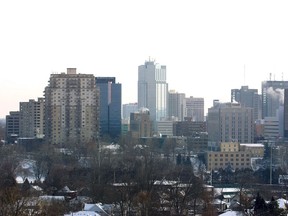CENSUS: Income growth, income disparity defining London's latest economic snapshot
When it comes to earning money, Londoners as a whole have been doing better during the past five years, the latest national census shows.

Article content
When it comes to earning money, Londoners as a whole have been doing better during the past five years, the latest national census shows. But when it comes to how that wealth is spread out, London ranks as one of the 10 worst cities in Canada for income equality across its population.
In the London region, the median household after-tax income was $71,000 in 2020, up from $62,400 in 2015, newly released census figures from Statistics Canada show. That’s an increase of 13.8 per cent during that period, the ninth fastest growth rate in the country and above both Ontario (12.8 per cent) and national levels (9.8 per cent).
But despite the increase – and the fact inequality overall dropped across Canada during the past five years – London ranked eighth among 41 census metropolitan areas in the Gini index, a metric that measures the dispersion of income in a population.
“I’m certainly not surprised at all,” Jacqueline Thompson, executive director of the anti-poverty agency LifeSpin, said of the ranking. “The cost of living in our community, like the cost of housing, far outweighs what most average people are making. If you’re earning minimum wage, you’re working two jobs just to pay your rent.
“There’s a few people who are at the top making lots of money, and they seem to be the ones making the decisions on what’s left over for people to share and there’s not a whole lot to go around,” Thompson said.
The overall decrease in inequality across Canada was attributed, in part, to support and relief programs, such as the Canada Emergency Response Benefit (CERB), implemented in response to the COVID-19 pandemic and which tended to benefit low-income families the most.
In London, for instance, that resulted in “remarkable” a drop in the number of people who reported earning less than $20,000 a year, said Don Kerr, a demographer and professor at King’s University College.
In 2015, 29.2 per cent of the population fell below that annual income bracket. In 2020, the figure was only 20.6 per cent.
“You can clearly see the impact of government transfers here in reducing the hardship of the lowest income Londoners,” Kerr said.
“You can well imagine that income inequality may very well jump in 2021 and 2022 without government support, even with the continued employment growth for our city.”
It was a concern shared by Glen Pearson, co-executive director of the London Food Bank.
He said the extra cash families received in the form of government subsidies launched at the onset of the pandemic helped many Londoners improve their living conditions somewhat.
But now that those supports are gone mostly, and coupled with the strains inflation is putting on families, the food bank is seeing near record numbers of Londoners seeking help, Pearson said.
“I think when it comes to poverty during COVID, it was remarkably stable. And that’s because the governments were giving out all these subsidies to help people who couldn’t go to work,” he said.
“Now, we’re really starting to see the inequalities even at the food bank; we’re starting to see our numbers grow and grow . . . (and) we expect to be at 4,000 families a month before the end of this year.”
London acting Mayor Josh Morgan said London’s ranking should help guide work in the city – particularly through its London Community Recovery Network – as it continues to work on its rebuild after COVID-19, noting positive trends are happening in the community.
One such positive trend is London’s economy, Morgan said, which has added thousands of jobs since 2020.
The total number of people employed in the London area in June was 294,800, about 30,000 more than in February 2020, before the start of the pandemic. The region’s unemployment rate sat at 5.8 per cent in June.
“I’m interested to see where we stand today,” Morgan said, adding the recovery network has a focus on creating both economic and social recovery.
“The London economy has been very hot, one of the fastest growing in the country . . . So, we cannot stop the work on ensuring that all Londoners have an equal opportunity to participate in the economic recovery.”






Postmedia is committed to maintaining a lively but civil forum for discussion. Please keep comments relevant and respectful. Comments may take up to an hour to appear on the site. You will receive an email if there is a reply to your comment, an update to a thread you follow or if a user you follow comments. Visit our Community Guidelines for more information.